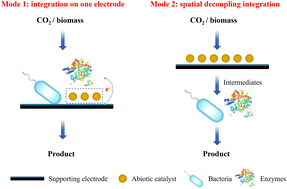Integrative electrochemical and biological catalysis for the mild and efficient utilization of renewable electricity and carbon resources
Abstract
Chemical catalysis and biological catalysis both play important roles in producing various fuels, chemicals, and materials conventionally. In view of renewable resource (biomass and CO2) utilization, combining both chemical and biological catalysis would create revolutionary routes that are more sustainable and efficient for the processing of these resources. Considering that electricity is usually the main form of renewable energy, electrocatalysis also plays an important role. Therefore, integrative electrochemical and biological catalysis for the simultaneous utilization of renewable energy and resources is attracting significant attention. In this review, such integrative processes and methods are summarized and discussed in depth and two integration modes are distinguished based on the use of electroactive/non-electroactive microorganisms. Intermediate mediated consecutive synthesis from CO2 or biomass to specific chemicals is shown to play a pivotal role, such as H2 enhanced microbial electrosynthesis (MES) and CO or formate mediated longer carbon chain product synthesis. Accordingly, the synthesis efficiency was improved significantly following the collaborative design of abiotic and biological catalysts, as well as route innovation. For example, an acetate productivity of 1330 g m−2 day−1 in MES and a low cost of 45 g kW h−1 for producing butanol and hexanol could be achieved, which shows great potential for industrial application. Integrative electrochemical and biological catalysis can convert CO2 or biomass feedstocks to a wide product distribution from C1 to C6+, and even large molecules such as sugars, lipids, starch, etc. This article exhibits the importance of integrative electrochemical and biological catalysis for efficient utilization of renewable carbon resources, the ways to integrate two different processes and some reflections for future research.



 Please wait while we load your content...
Please wait while we load your content...